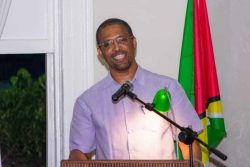Chairman of the opposition coalition APNU, Dr. Rupert Roopnaraine says that he will be seeking further information on a proposed US$500 million investment by the Malaysian syndicate, Wee Boon Ping Group of Companies.
“I think that these are matters that are important enough to be brought to the attention of the National Assembly,” he told Stabroek News yesterday. Stabroek News had reported that Bornion Guyana Inc. (BGI) – the local subsidiary of the Wee Boon Ping Group of Companies – has begun the first phase of what it envisions will eventually be a US$500 million investment in Guyana’s agricultural and forestry sectors covering oil palm, rubber and soya, among other crops.
When contacted yesterday, Roopnaraine said that he read the story in yesterday’s Sunday Stabroek and noted that it is a very “ambitious” project. Alluding to previous comments he had made on similar investments, he said that it is not satisfactory to have to rely on the newspapers to get the details on such matters. APNU will be seeking further information on the investment, he said.
Last month, Roopnaraine had called on government to come clean on two potentially major agriculture investments. The two Memoranda of Understanding for large agricultural projects which were quietly signed by the government with Indian and Chinese companies raised disquiet as their terms were not publicized. Roopnaraine had said that the first knowledge of dealings with the D Y Patil Group and China Paper came to his attention through reporting in the Stabroek News. He said that “with these MoUs we are of the firm belief that they need to be fully ventilated and brought to the National Assembly.”
Prior to the reportage in the Stabroek News there had been no information from the government on the details of MoUs clinched with the two companies. In addition, apart from a release from the Government Information Agency (GINA) in April 2012 reporting on the visit of Wee Boon Ping Group officials, there has been no word from the government on this deal either. Last week, Minister of Agriculture Dr. Leslie Ramsammy told Stabroek News that BGI has been allocated 10,000 acres in the Canje Basin to plant rubber. The company has already started its nursery for the rubber plants, he said.
According to information provided, the company plans to establish a state-of-the-art industrial complex by 2017 to produce value-added products based on the commercial scale cultivation of 120,000 hectares of rubber, 100,000 hectares of oil palm, 60,000 hectares of corn, and 30,000 hectares of cassava.
During 2018-2020, it is envisioned that 80,000 hectares will be cultivated with acacia, rice and assorted beans. “The 10-hectare industrial complex will include a large laboratory, several plants for processing and packaging rubber and food crops, a refinery for processing and refining palm oil and other ancillary infrastructure that will see Guyana producing and exporting a range of processed, value-added products,” BGI’s project summary says.
It says that in setting up the complex, full use will be made of green energy sources. “Another major item in the planned investment is the construction of a pier with warehouse and refrigeration facilities on left bank Corentyne River to ensure timely movement of large volumes of goods being exported,” it says.
The company envisages that up to 5,000 people will be employed in nurseries, tending operations in plantations, food processing in factories, rubber and palm oil processing, in support services, and in research.
With the Canje basin appearing to be the major focus of the company’s operations, a question that has arisen is the availability of water for such large-scale operations. Last February, in a letter published in the Stabroek News, engineer Charles Sohan had said that irrigation supply from the Canje River with supplemental flows from the Torani Canal is insufficient to meet the irrigation demands for existing rice and sugar cultivations in the Canje River Basin.
He had said that the previous and the present Government were made aware of the problem as engineering studies have recommended that for additional water supply, a dam and reservoir will have to be built in the upper reaches of the Canje River. At the same time the Torani Canal should be widened and deepened and additional sluice doors added at both ends of the Canal to increase flows from the Berbice River into the Canje River, Sohan said. “To date no action has been taken to execute any of these recommendations although rice and sugar cultivation have been expanding with increased irrigation demands as users vie with each other for the ever dwindling water supply,” he had said.
Others such as Tony Vieira had also pointed to the shortage of water experienced during dry spells. Vieira had noted that there is no conservancy in East Berbice and communities and all agricultural operations in the area including Black Bush Polder “draws directly from the Canje River and even today in dry periods the level of the Canje becomes so low that salt water from the Atlantic ocean can intrude as far as where Albion draws water from it, and this includes Rose Hall and Black Bush Polder and everyone in between.”
He noted that the Torani Canal had been dug to relieve the situation and was designed to bring water from the Berbice River to the Canje River to supplement the water requirements of the sugar estates and rice farmers and other agricultural operations in East Berbice.
He had posited that possible solutions include increasing the size of the Torani canal or the building of a reservoir which would be costly.








